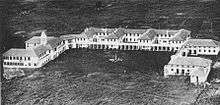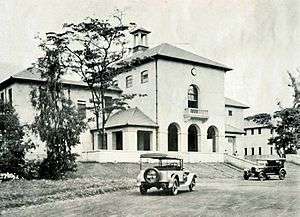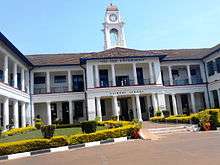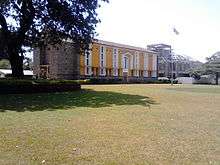Nairobi School
| Nairobi School | |
|---|---|
| Location | |
|
Nairobi Kenya | |
| Information | |
| Type | National, Public |
| Motto | To The Uttermost |
| Established | 1902 |
| Principal | Mr. Paul Kibet |
| Number of students | 1100 |
| Campus | Westlands, Nairobi |
| Color(s) | Blue, Yellow, Grey and White |
| Website | http://nairobischool.ac.ke |
Nairobi School is a national secondary school in Nairobi, Kenya. It was founded in 1902 by the British settlers who had made Nairobi their home after the construction of the Uganda Railway. In 1925 Lord Delamere and Sir Edward Grigg, then Governor of Kenya, separated the European Nairobi School into a senior boys' school (Prince of Wales School), a senior girls' school (Kenya High School) and a junior school (Nairobi Primary School).
In 1931 a new school was built at the 250-acre (1.0 km2) site at Kabete, the main school buildings being designed by Herbert Baker. The school was then named the Prince of Wales School but following Kenya's independence the school was renamed to Nairobi School in 1965. The school is popularly referred to as 'Patch'.


History of Nairobi School

Nairobi school was initially started in the year 1902 around the present day Nairobi Railways club as a European school to serve the families of the I.B.E.A Company and awhile later the white settler community. Out of the foresight of the late Lord Delamere in proposing the building of a senior Boys school (now Nairobi Primary), and the support of the then governor, Sir Edward Grigg, the railway reserve grounds near Kabete were set aside for the future planning.
In 1928, Sir Herbert Baker was commissioned to plan a school similar to Britain's Winchester school, attended by both Lord Delamere and the then Governor-Kenya colony, in Winchester, an old town in Southern England dating from about 516AD, after the Romans left England. It was a major administrative and silver minting center, and hence, a Saxon Capital of England from 1066AD. Captain B.W.L. Nicholson from Royal Naval College Dartmouth was appointed Headmaster of the European Nairobi School while planning for the New Boys School to be built at Kabete. Captain Nicholson designed the School uniform and discipline based on the British Naval system, meanwhile Mrs. Nicholson and Rev. Gillett worked on the gardens of the new School.

On 24 September 1929 the foundation stone was laid by his Excellency Lt. Col. Sir Edward Grigg K.C.M K.C.V.O, D.S.O, M.C, Governor of Kenya colony, for a school with a capacity of 80 boys. Interestingly under the stone were preserved a copy of the day. The School opened in 1931 not only for the 80 boys it was designed, but with 84 boarders and 20-day boys. The headmaster felt the old name 'Kabete Boys Secondary School' was too clumsy and it was given the name 'Prince of Wales School' as a special case, the Prince of Wales feathers were to be inserted between the horns of a Royal Impala as the School badge, accompanied by the school motto "TO THE UTTERMOST".
There was high enrolment eventually than initially anticipated and this called for new classrooms but there was a general shortage of cement and thus the first wooden classrooms were erected around 1938. The School population increased further because of the second world war and the Kenya Governor authorised the building of corrugated iron dormitories (the group of buildings that was later to become Intermediate/Fletcher House – the current Music Room). It was called ‘Lacey's Landies’. The effects of the war were felt more when the Italians joined in and because of fear of their bombing the School, it was made a day school. In June 1940, the military hospital took over the buildings and each of the students was moved back to the European Nairobi School (the present Nairobi Primary School.)
During the Christmas break of 1941, the whole school came back to Kabete on its own grounds and the space at the European Nairobi School was taken over by the Girls' Secondary School. In 1942, European education was made compulsory and enrolment increased so much that new temporary classrooms were needed. The wooden classrooms were erected as a "temporary wartime measure"! Clive, Grigg, Hawke and Rhodes Houses (the only four houses at the time) were all accommodated in the permanent building adjacent to the tuition block. Today those are two houses, known as Marsabit and Elgon. The period 1943 to 1944 saw the Rhodes/Nicholson complex being built, which is the Serengeti and Athi Houses complex today. The Sanatorium and School Hall were further constructed in 1945 as a sister school, the Duke of York school (today, Lenana School) was founded in 1948.

Today the school, named after Kenya's capital, is one of the leading National Schools in the country. Nairobi School sits on over 200 acres of land about 11 kilometres from the city centre and has over 1100 students currently enrolled.
School Curriculum
Nairobi School follows the 8-4-4 system of education. The school curriculum is provided by the Kenya Institute of Curriculum Development, a department of the Ministry of Education in Kenya. The subjects offered in the school are as follows:
In Form 1 and 2, the compulsory subjects are: English, Kiswahili, Mathematics. Biology, Physics, Chemistry, History and Government, Geography and Business Studies. Students may choose between Christian Religious Education and Islamic Religious Education. They may also choose one subject among the following: Agriculture, Art and Design, Computer Studies, Metalwork, Woodwork, French or Music.
In Form Three and Four, English, Kiswahili, Mathematics, Biology, Physics and Chemistry are compulsory subjects, students may then choose at least one subject from the remaining courses taught in Form 1 and 2.[1]
School Anthem
The Nairobi School (Patch) anthem was adopted from a certain patriotic song which the Muungano National Choir composed in celebrating the unopposed election of former President Daniel Moi in 1983.
Here is the school anthem in Swahili:
Patchi Kipenzi Changu, Mimi nimeapa (Patch my Love, I have Sworn)
Milele na Milele, Nitakufa na wewe (Forever and Ever, I will die with you)
Patchi kipenzi hakuna mwingine duniani (Patch my Love, there is none like you in the world)
Patchi kipenzi hakuna mwingine duniani (Patch my Love, there is none like you in the world)
School Hymn
Nairobi School has a school hymn, which is part of the Christian Hymns. The hymn is called Trust and Obey:
When we walk with the Lord, in the light of His Word,
What a glory He sheds on our way!
While we do His good will, He abides with us still,
And with all who will trust and obey.
Refrain:
Trust and obey, for there’s no other way
To be happy in Jesus, but to trust and obey.
Not a shadow can rise, not a cloud in the skies,
But His smile quickly drives it away;
Not a doubt or a fear, not a sigh or a tear,
Can abide while we trust and obey.
Refrain:
Not a burden we bear, not a sorrow we share,
But our toil He doth richly repay;
Not a grief or a loss, not a frown or a cross,
But is blessed if we trust and obey.
Rerfain:
But we never can prove the delights of His love
Until all on the altar we lay;
For the favor He shows, for the joy He bestows,
Are for them who will trust and obey.
Refrain:
Then in fellowship sweet we will sit at His feet,
Or we’ll walk by His side in the way;
What He says we will do, where He sends we will go;
Never fear, only trust and obey.
Refrain:
Nairobi School Cadets-Kenya Regiment
Nairobi School had a cadet training course of paramilitary standards in which students could enroll. The cadet course was started in the colonial era when Mau Mau activity was at its peak. After the colonial era Kenya Regiment went on with the cadet course until it was stopped by the government after the unsuccessful 1982 coup d'état. The cadet section had uniforms, guns, ammunition, an armoury, a parade ground with adjacent stores and offices and a shooting range.
Kenya Regiments cadets took part in march pasts during National Days. They also used to be assigned sentry duty at the main gate and around the school at night. Successful cadets who passed out would be issued rank. The cadets, after completion of their form 6 education, could further their careers by joining the armed forces as officer cadets.
Houses

Nairobi school has eight houses, to one of which each student belongs. The houses serve as dormitories, as well as for student organisation for the purpose of sports days, dining hall seating, chapel seating and school assembly. Students develop strong links with members of their houses, and these become evident on sports days, particularly in inter-house rugby contests; rugby being the most popular school game. The houses are:
Athi house (formerly Rhodes house);[2]
Baringo house (formerly Hawke house);[3]
Elgon house (formerly Clive house);[4]
Kirinyaga house (formerly Grigg house);[5]
Marsabit (formerly Scott house);[6]
Naivasha house (formerly known as Fletcher house);[7]
Serengeti house (formerly known as Nicholson house)[8] and
Tana house (formerly junior house ).[9]
The name changes, reflecting geographical areas in Kenya, were adopted in 1975 as part of a deliberate policy of Africanisation.
In popular culture
The administration block was used as the setting for the Government House in the Oscar-winning movie Out of Africa, based on a book with the same title by the Danish writer Karen Blixen.[10]
Notable alumni
'Old Boys' of the school are called Old Cambrians.
- Colin Rawlins, British colonial civil servant
References
- ↑ "Nairobi School — Curriculum". www.nairobischool.ac.ke. Retrieved 2015-11-05.
- ↑ "Rhodes/Athi House Photos — The Prince of Wales School / Nairobi School". www.oldcambrians.com. Retrieved 2015-11-05.
- ↑ "Hawke/Baringo House Photos — The Prince of Wales School / Nairobi School". www.oldcambrians.com. Retrieved 2015-11-05.
- ↑ "Clive/Elgon House Photos — The Prince of Wales School / Nairobi School". www.oldcambrians.com. Retrieved 2015-11-05.
- ↑ "Grigg/Kirinyaga House Photos — The Prince of Wales School / Nairobi School". www.oldcambrians.com. Retrieved 2015-11-05.
- ↑ "Welcome". SimpleSite.com. Retrieved 2015-11-05.
- ↑ "Intermediate/Fletcher/Tana House Photos — The Prince of Wales School / Nairobi School". www.oldcambrians.com. Retrieved 2015-11-05.
- ↑ "Nicholson/Serengeti House Photos — The Prince of Wales School / Nairobi School". www.oldcambrians.com. Retrieved 2015-11-05.
- ↑ "Intermediate/Fletcher/Tana House Photos — The Prince of Wales School / Nairobi School". www.oldcambrians.com. Retrieved 2015-11-05.
- ↑ "The thinking behind Nairobi's grand schools". www.nation.co.ke. Retrieved 2015-11-05.
External links
- Nairobi School website
- The Old Cambrian Society (Prince of Wales School/Nairobi School Alumni)----
- The Nairobi School History----
- Satellite picture of Nairobi School on Google Maps
Coordinates: 1°15.51′S 36°45.98′E / 1.25850°S 36.76633°E